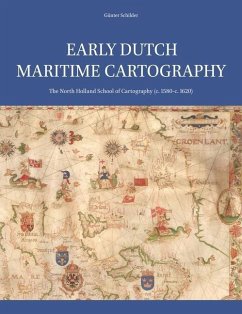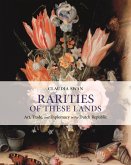Winner of the 2019 Menno Hertzberger Prize for Book History and Bibliography
This book is an exposition of an important, yet previously unknown chapter in the history of Dutch maritime cartography. While Amsterdam was developing into Europe's most vital commercial hub in the seventeenth century, demanding and controlling the production of maps and sea-charts, a major School of Cartography was already flourishing in the so-called 'Kop van Noord-Holland' region just north of Amsterdam. This School specialised in the production of small-scale charts of larger areas, including the European coastlines and the Indian and Atlantic Oceans. Its masters used to call themselves 'caert-schrijvers' or 'map-scribes' when clarifying their profession. The cities of Enkhuizen and Edam were important trading ports and as such provided an ideal environment for developing into centres of cartography, serving sea-borne navigation.
Apart from the well-known printed pilot guides by Lucas Jansz Waghenaer, the output of these 'caert-schrijvers' consists mainly of manuscript charts on vellum. Copies, though few they are, nowadays can be found across the globe. Sea-charts provided invaluable on-board navigation assistance to ship captains. However, another surprising contemporaneous purpose for financing these charts become popular. Rich ship owners and merchants would commission new charts to serve as wall-decoration as well as a reference point for their maritime-related conversations. They feature a decorative lay-out filled with magnificent colours. Moreover, many of these charts are embellished with miniature paintings, certainly making them some of the most beautiful exemplars ever produced by Dutch cartography during its Golden Age.
Hinweis: Dieser Artikel kann nur an eine deutsche Lieferadresse ausgeliefert werden.
This book is an exposition of an important, yet previously unknown chapter in the history of Dutch maritime cartography. While Amsterdam was developing into Europe's most vital commercial hub in the seventeenth century, demanding and controlling the production of maps and sea-charts, a major School of Cartography was already flourishing in the so-called 'Kop van Noord-Holland' region just north of Amsterdam. This School specialised in the production of small-scale charts of larger areas, including the European coastlines and the Indian and Atlantic Oceans. Its masters used to call themselves 'caert-schrijvers' or 'map-scribes' when clarifying their profession. The cities of Enkhuizen and Edam were important trading ports and as such provided an ideal environment for developing into centres of cartography, serving sea-borne navigation.
Apart from the well-known printed pilot guides by Lucas Jansz Waghenaer, the output of these 'caert-schrijvers' consists mainly of manuscript charts on vellum. Copies, though few they are, nowadays can be found across the globe. Sea-charts provided invaluable on-board navigation assistance to ship captains. However, another surprising contemporaneous purpose for financing these charts become popular. Rich ship owners and merchants would commission new charts to serve as wall-decoration as well as a reference point for their maritime-related conversations. They feature a decorative lay-out filled with magnificent colours. Moreover, many of these charts are embellished with miniature paintings, certainly making them some of the most beautiful exemplars ever produced by Dutch cartography during its Golden Age.
Hinweis: Dieser Artikel kann nur an eine deutsche Lieferadresse ausgeliefert werden.
"[...] this work is comprehensive, well organized, profusely illustrated and enjoyable to read. It is an absolute must for the reference shelves of any map library as well as for anyone interested in the lore of the sea."
Richard Pflederer, in: The Portolan , Winter 2017, pp. 74-75.
"the book is a feast for the eye for the number and the splendour of the illustrations, many of which are known to specialists in the field, but numerous ones will be new to those who have been reading the literature in this specific field. [...] This book by Schilder is a must have for anyone who is interested in almost any aspect of Dutch and world history and who has an open eye for the interface between navigation, mapping and art." Kees Zandvliet, in Imago Mundi , vol. 70, part 2 (2018), pp. 242-243.
"As we have come to expect from Günter Schilder over the years, this book is yet another monumental piece of scholarship on the history of early modern Dutch cartography. [...] the book is beautifully illustrated and completely up to date bibliographically, and will be an indispensable reference work for maritime historians working on early modern European shipping and early Dutch colonialism for decades if not longer. All libraries and heritage institutions who take their map collections seriously should place this book on the open shelves of their reading rooms, always available for consultation. Most importantly, the book is the paragon of virtue in terms of meticulous and wide-ranging research on handwritten, printed, visual, and cartographic sources from collections across the world. It is, in one word, a masterpiece. [...] it is difficult to envisage how scholarship on maritime cartography can ever become better than this." Michiel van Groesen, in International Journal of Maritime History , vol. 29, issue 4, pp. 974-975.
Richard Pflederer, in: The Portolan , Winter 2017, pp. 74-75.
"the book is a feast for the eye for the number and the splendour of the illustrations, many of which are known to specialists in the field, but numerous ones will be new to those who have been reading the literature in this specific field. [...] This book by Schilder is a must have for anyone who is interested in almost any aspect of Dutch and world history and who has an open eye for the interface between navigation, mapping and art." Kees Zandvliet, in Imago Mundi , vol. 70, part 2 (2018), pp. 242-243.
"As we have come to expect from Günter Schilder over the years, this book is yet another monumental piece of scholarship on the history of early modern Dutch cartography. [...] the book is beautifully illustrated and completely up to date bibliographically, and will be an indispensable reference work for maritime historians working on early modern European shipping and early Dutch colonialism for decades if not longer. All libraries and heritage institutions who take their map collections seriously should place this book on the open shelves of their reading rooms, always available for consultation. Most importantly, the book is the paragon of virtue in terms of meticulous and wide-ranging research on handwritten, printed, visual, and cartographic sources from collections across the world. It is, in one word, a masterpiece. [...] it is difficult to envisage how scholarship on maritime cartography can ever become better than this." Michiel van Groesen, in International Journal of Maritime History , vol. 29, issue 4, pp. 974-975.








